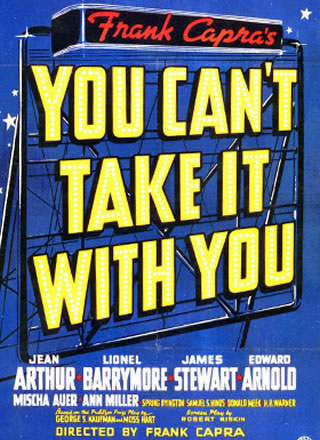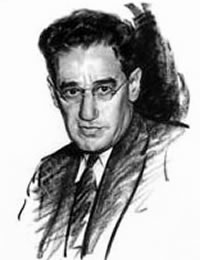The Man Who Came To Dinner
(1939)
By Moss Hart and George S. Kaufman
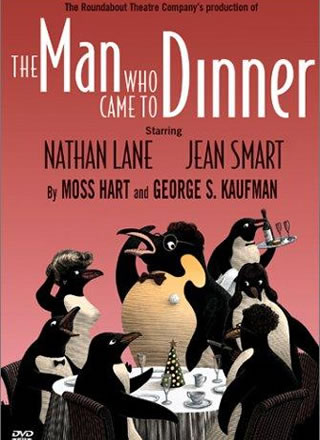
Cast size: 14 men, 9 women, doubling possible; one set
The Man Who Came to Dinner rolled onto Broadway at the Music Box Theatre on October 16, 1939. It became an overnight smash hit and stayed, rather like Whiteside, for a protracted visit of 739 performances. (During its Boston tryout, Paris had fallen to the Nazis, forcing a last-minute revision to the script where a phone call from Whiteside to Gertrude Stein in Paris became, instead, a call to Walt Disney in Hollywood.)
For professional performance rights, contact: Concord Theatricals
For amateur performance rights, contact: Dramatists

Table of Contents
The Plot
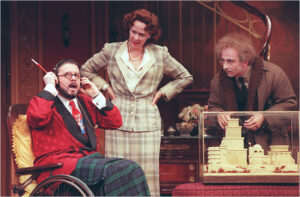 “Portly Sheridan Whiteside, critic, lecturer, wit, radio orator, intimate friend of the great and near great, met his Waterloo in the shape of a small piece of ice on the doorstep of Mr. and Mrs. Ernest W. Stanley, of Mesalia, Ohio, while trekking across the country on his annual lecture tours. Result: the idol of the air waves rests until further notice in the home of the surprised Mr. and Mrs, Stanley. Possibility: Christmas may be postponed this year.”
“Portly Sheridan Whiteside, critic, lecturer, wit, radio orator, intimate friend of the great and near great, met his Waterloo in the shape of a small piece of ice on the doorstep of Mr. and Mrs. Ernest W. Stanley, of Mesalia, Ohio, while trekking across the country on his annual lecture tours. Result: the idol of the air waves rests until further notice in the home of the surprised Mr. and Mrs, Stanley. Possibility: Christmas may be postponed this year.”
So runs the lead article in the Christmas 1939 issue of Time magazine. Whiteside turns the Stanley household upside down, forcing everyone in town to cater to his egotistical demands. Meanwhile, his beloved secretary has given her notice after falling in love with a local reporter, and Whiteside must engage every weapon in his considerable arsenal of guile and manipulation to keep her in his employ—including blackmail, deceit, and the intervention of the fading sexpot actress Lorraine Sheldon and the elegant British wit of playwright Beverly Carlton. A three-ring circus of machinations and celebrity appearances ensues.
About the Play
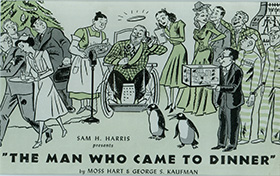 Broadway critic, book reviewer, radio personality, lecturer, erstwhile actor, gourmand, taste-tester and taste-maker, the corpulent Alexander Woollcott wielded an opinion and a rapier-like wit that few could match. But, in the middle of the thirties, Woollcott had caught the acting bug as well. He demanded that Kaufman and Hart—personal and professional colleagues–concoct a vehicle for him. Kaufman and Hart hemmed and hawed for several months, but then Hart remembered a time when Woollcott made a surprise visit to Hart’s Bucks County estate. He commandeered Hart’s own bedroom, demanded the heat be turned off and requested a chocolate malted and a chocolate cake. The next morning after loudly excoriating the household staff for incompetence and dishonesty, Woollcott wrote in the guest book:
Broadway critic, book reviewer, radio personality, lecturer, erstwhile actor, gourmand, taste-tester and taste-maker, the corpulent Alexander Woollcott wielded an opinion and a rapier-like wit that few could match. But, in the middle of the thirties, Woollcott had caught the acting bug as well. He demanded that Kaufman and Hart—personal and professional colleagues–concoct a vehicle for him. Kaufman and Hart hemmed and hawed for several months, but then Hart remembered a time when Woollcott made a surprise visit to Hart’s Bucks County estate. He commandeered Hart’s own bedroom, demanded the heat be turned off and requested a chocolate malted and a chocolate cake. The next morning after loudly excoriating the household staff for incompetence and dishonesty, Woollcott wrote in the guest book:
“I wish to say on my first visit to Moss Hart’s house, I had one of the most unpleasant evenings I can ever recall having spent.”
Hart wondered out loud what would have happened if Woollcott had broken his leg on the way out and been forced to bivouac perpetually in the house. The proverbial light went on.
“This can be a very funny play,” Hart told Kaufman. “All we have to have now are three very funny acts,” he replied.
They worked through the spring of 1939, incorporating as many bits of Woollcott’s personality into the character of Sheridan Whiteside as possible.
Hart wrote:
“In talking about Woollcott, we decided to use only public aspects of his character…his lectures, his broadcasts, his charm, his acidulousness, his interest in murders, and all of this had to be worked into the plot of the play.”
In the end, Woollcott balked at playing this version of himself. Relieved, the authors bandied about the names of John Barrymore, Adolphe Menjou, and Robert Morley before settling on Monty Woolley, a Yale professor and actor. Woollcott eventually starred in the second touring company on the West Coast. After the curtain calls, he would often step down to the footlights and say to the thrilled audience in his nasal, high-pitched, imperious voice:
“It’s not true that this role of the obnoxious Sheridan Whiteside was patterned after me. Whiteside is merely a composite of the better qualities of the play’s two authors.”
Stage history
The Man Who Came to Dinner rolled onto Broadway at the Music Box Theatre on October 16, 1939. It became an overnight smash hit and stayed, rather like Whiteside, for a protracted visit of 739 performances. (During its Boston tryout, Paris had fallen to the Nazis, forcing a last-minute revision to the script where a phone call from Whiteside to Gertrude Stein in Paris became, instead, a call to Walt Disney in Hollywood.) A national touring company featuring Clifton Webb was also successful. Once its success had been assured, Woollcott became stage-hungry again.
The authors agreed that he could star in the second touring company on the West Coast. A 1942 film starring Woolley, and featuring Bette Davis and Jimmy Durante was also a wartime hit (featuring a “cameo” by the voice of Eleanor Roosevelt). Hart himself played Whiteside in a U.S.O tour of the South Pacific in 1944. The play has been revived many times on stage and television: notable Whitesides have included Orson Welles, Ellis Rabb, and, mostly recently, Nathan Lane in a 2000 production at the Roundabout Theater Company.
Other Plays in the Catalogue
In a rare collaboration with his Algonquin Round Table comrade, Alexander Woollcott, Kaufman wrote his only murder mystery.
A dramatic epic story of assimilation, patriotism and prejudice in America. Kaufman and Hart’s most serious play, The American Way galvanized audiences at the large Century Theater in Rockefeller Center in the last days of the 1930s; it starred Frederic March as the leading character.
By Moss Hart and George S. Kaufman. Cast size: 14 men, 9 women, doubling possible; one set. The Man Who Came to Dinner rolled onto Broadway at the Music Box Theatre on October 16, 1939. It became an overnight smash hit and stayed, rather like Whiteside, for a protracted visit of 739 performances.
Table of Contents
Contact Us Today
Interested in bringing George S. Kaufman’s timeless plays to your stage?
Please refer to the contact information for each specific play on the various collection pages for direct amateur and professional licensing information.
Plays are represented by Concord Theatricals, Broadway Dramatic Licensing, and Music Theatre International respectively
If you are interested in first-class performance or film/television rights:
In the US, George S. Kaufman’s plays are represented by:
CPK Artists, LLC
In the UK, George S. Kaufman’s plays are represented by:
Alan Brodie Representation
For more information about George S. Kaufman or this website, contact:
Laurence Maslon
Literary Trustee, George S. Kaufman Estate


